Exponential advances in data science are radically transforming healthcare
Traditional healthcare models are reactive. Patients primarily present with symptoms and doctors diagnose disease. However, access to big datasets and advanced data analytics is driving the development of a prevention-oriented care dynamic, resulting in reduced morbidity and mortality through personalized treatments.
Data can now circulate not just between the patient and provider, but from the patient to medical researchers to replace many studies typically conducted in the laboratory.
Data Science Applications
We see the early seeds of this shift in the growing popularity of wearable, personalized monitoring devices, and smartphone applications to track daily health indicators. Most hospital systems have replaced paper records with electronic medical records (EMRs) and use natural language processing algorithms. Machine learning algorithms, such as those that collect and analyze heart rate and breathing patterns, are demonstrating equal and even increased effectiveness at diagnosing disease compared to humans.
Clinical data such as doctors’ notes, lab results, and medical images can be reviewed for errors and omissions related to procedural gaps. Participants for clinical trials can be more effectively screened and recruited via the review of patient and site data. Insights on home health management can also be gained from analyzing trends in website traffic to sites such as MayoClinic.com and WedMD.
Medical researchers are developing targeted drugs and treatment plans utilizing diverse datasets including those from genomics and gene-sequencing studies. Atomwise, an artificial intelligence technology startup, used virtual models and neural networks to evaluate how 7,000 existing drugs interacted with the Ebola virus. The experiment took only about a day instead of months to complete and resulted in the discovery of two tested drugs that infer cell resistance to the virus (Atomwise Inc., 2015). Another valuable application is tracking consumer drug safety and efficacy.
It may not be long until implanted wearables become the norm and create continuous health data streams to track one’s health status and alert a need for medical care long before symptoms arise.
Data analytics can also improve healthcare facility operations to enhance patient and provider experience. Some examples include gauging customer satisfaction and loyalty, predicting inventory and staffing needs, reducing wait times, and even helping build programs for emergency preparedness.
See John Snow Labs’ 5-minute visualization of how medical device company locations can be mapped for inventory planning processes.
Data Science Gaps
To process and apply the growing volume of healthcare data [15 exabytes (one exabyte = one billion gigabytes) were produced in 2013 and an estimated 2,314 exabytes will be produced in 2020 (IDC, 2014)], healthcare organizations must acquire data science expertise and infrastructure. Associated challenges they will be faced with are privacy concerns related to data sharing and cybersecurity issues.
Incorporating Data Science
As the costs of healthcare rise across the globe, the development of data science strategies to reduce inefficiencies in the healthcare sector is imperative. Organizations will benefit from increased profits through reduced costs and increased patient access. The dramatic rise in the availability of big data in healthcare and research has and will continue to be mirrored by the rapid employment of data science and predictive analytics in every sector of the healthcare industry.
John Snow Laboratories offers a team of healthcare research specialists and 1,800 datasets across 18 areas of human health and well-being as well as healthcare billing, census, cost, payment, provider, guideline, measure, terminology, hospital, and physician data from the United States and United Kingdom. John Snow Labs is available for consultations on areas where our data operations teams can keep your healthcare organization ahead of the data science curve.
Discover how integrating tools like Generative AI in Healthcare and Healthcare Chatbot systems is transforming data science, enhancing patient care, and supporting more efficient healthcare solutions.
Referencies
Agrawal, S. (2017). Why Hospitals Need Better Data Science. Harvard Business Review [online] Available at: https://hbr.org/2017/10/why-hospitals-need-better-data-science [Accessed 16 Feb. 2018]
Atomwise Inc. (2015). Atomwise Finds First Evidence Towards New Ebola Treatments. [online] Available at: http://www.atomwise.com/atomwise-finds-first-evidence-towards-new-ebola-treatments/ [Accessed 16 Feb. 2018]
International Data Corporation (2014). The Digital Universe of Opportunities: Rich Data and the Increasing Value of the Internet of Things. [online] Available at: https://www.emc.com/collateral/analyst-reports/idc-digital-universe-2014.pdf [Accessed 16 Feb. 2018]
Mingle, D. (2015). 4 Big Reasons Why Healthcare Needs Data Science. IDG Communications[online] Available at: https://www.cio.com/article/3001216/analytics/4-big-reasons-why-healthcare-needs-data-science.html [Accessed 16 Feb. 2018]
Stanford Medicine (2017). Stanford Medicine 2017 Health Trends Report, Harnessing the Power of Data in Health. [online] Available at: http://med.stanford.edu/content/dam/sm/sm-news/documents/StanfordMedicineHealthTrendsWhitePaper2017.pdf [Accessed 16 Feb. 2018]





























